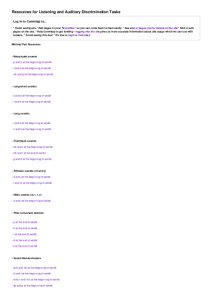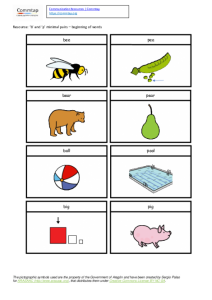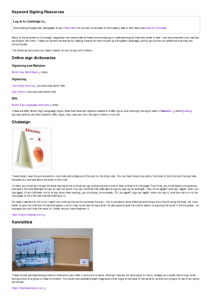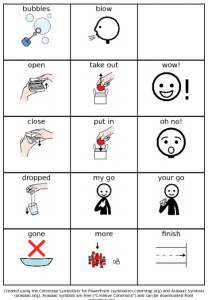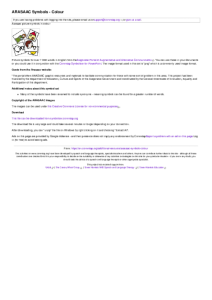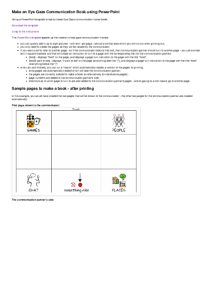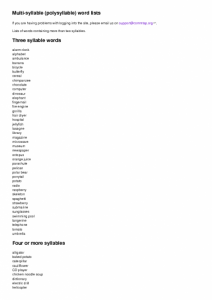Search
User login
Topic “Early Years (0-5yrs)”
Early Years (0 to 5 years)
Resources for Listening and Auditory Discrimination Tasks
Created 12 January 2021; updated 7 December 2021.
Keyword Signing Resources
Many of the activities on Commtap - especially the ones aimed at those communicating or understanding at three key words or less - can be enhanced if you use key word signs with them. These can benefit the learner by making it easier for them to pick up the spoken language, and by giving them an additional way they can communicate.
The following resources can make it easier for you to sign with children.
Online sign dictionaries
Signalong and Makaton
British Key Word Signs (free).
Signalong
Text-a-sign service (annual subscription fee).
Sign library (annual subscription fee).
BSL
British Sign Language Dictionary (free).
Language Prompt Sheets for Activities
This resource contains language prompt sheets for three activities:
- blowing bubbles;
- building a tower;
- reading a book.
Use these sheets with a child to help minimise and simplify the language you are using with the child, and to give them an alternative means of talking about the activity if they need it.
The prompt sheet helps you to think of different types of words and phrases you can use with the child - including verbs (action words), words for commenting, words for taking turns and words for starting and finishing.
These examples use Arasaac picture symbols and Mulberry picture symbols (both free "Creative Commons" symbols sets). They were created using the Commtap Symboliser for PowerPoint.
Created 30 September 2018; updated 22 October 2021.
For child to look at their peers and use their names when in a turn taking activity
| Activity/strategy name and materials required | How to do the activity | Key principles for doing the activity and comments |
|---|---|---|
| Play a game with adult supervision Marble run; Bricks for sharing building and knocking down a tower; Any lotto game where pictures have to be matched; Skittles; Pushing cars down a run/pipe. pictures of children taking part |
| Keep turns short and snappy so children don't need to wait too long. Keep the time spent on the whole game short and snappy so children don't get bored. Support good waiting by saying "you are waiting..." sometimes the child will find it easier to wait if they have something to hold while they wait - this could be a waiting symbol.
|
ARASAAC Symbols - Colour
Arasaac picture symbols in colour
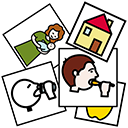
Picture symbols for over 11000 words in English from the Aragonese Portal of Augmentative and Alternative Communication. You can use these in your documents or you could use it in conjunction with the Commtap Symboliser for PowerPoint. The image format used in this set is "png" which is a commonly used image format.
Encouraging eye gaze communication (no tech)
Created 16 November 2016; updated 6 December 2024.
Encouraging eye gaze communication (no tech)
Helping a child to use/begin to use an eye gazing to communicate choices or an action they would like you to do - with pictures and (optionally) a perspex eye gaze frame (i.e. sheet of clear plastic you hold up between you and the child to fix communication pictures on).
Encouraging looking at an appropriate picture
In this situation you know what the child wants - e.g. they want the mirror chimes, or they want you to spin them, but they are not looking at the appropriate picture or picture symbol. This can happen if the child is new to this communication method, or you've put pictures in a different position on the frame in front of the child, or you are presenting new picture symbols.
Try
Make an Eye Gaze Communication Book using PowerPoint
Using a PowerPoint template to easily create Eye Gaze communication frame books.
This PowerPoint template speeds up the creation of eye gaze communication frames:
Make an Eye Gaze Communication Book using PowerPoint
Created 23 May 2016; updated 24 August 2021.
Multi-syllable (polysyllable) word lists
Lists of words containing more than two syllables.
Three syllable words
alarm clock
alphabet
ambulance
banana
bicycle
butterfly
cereal
chimpanzee
chocolate
computer
dinosaur
elephant
fingernail
fire engine
gorilla
hair dryer
hospital
jellyfish
lasagne
library
magazine
microwave
museum
newspaper
octopus
orange juice
parachute
pelican
polar bear
ponytail
potato
radio
raspberry
skeleton
spaghetti
strawberry
submarine
sunglasses
swimming pool
Work out how likely an assessment result could have been achieved by chance
A calculator that you can use to work out how likely that a child/adult could have come up with a score in an assessment test by chance. For example, suppose you had 12 pairs of pictures, and a child was able to point to 9 of them correctly from an instruction - is that a good result or not? No hard maths involved!
Support Commtap to keep it online
Thank you for visiting Commtap.
Please read this message as it is extremely important.
- Visitor donations mean we can continue to host over 1,000 free activities to support speech, language, and communication development.
- Visitor donations mean we can continue to provide free resources to address a wide range of communication needs, including limited speech or language, interaction challenges, and needs associated with conditions such as developmental language disorder, autism, and cerebral palsy.
- Visitor donations mean we can continue to provide resources to support the work of speech and language therapists, teachers, teaching assistants, parents, and carers.
- Visitor donations mean we can continue to provide the free key word sign dictionary (bks.org.uk) which has over 2,000 Makaton and Signalong signs.
We know that not everyone is able to afford to pay to access these resources, however, if you can, please make a donation to keep the site going.
Thank you
Google ads on this page are provided by Google Adsense - and their presence does not imply any endorsement by Commtap. Report a problem with an ad on this page. Log in (for free) to avoid seeing Google ads.
